
British postcard by J. Beagles & Co., London, no. 1024. Photo: Johnston & Hoffmann. (The photo studio of Johnston and Hoffmann was an important studio in Calcutta, India, at the turn of the last century. Possibly Burke was photographed in the studio on a stage tour to India, or Johnston & Hoffmann also had a British studio.)

British postcard by Rapid Photo Co, London, no. 2216. Photo: Bassano.
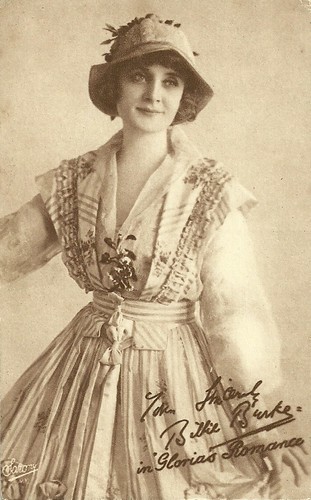
British postcard. Photo: Sarony, New York. Billie Burke in the serial Gloria's Romance (Walter Edwin, Campbell Gollan, 1916), produced by George Kleine.

British postcard. Photo: Sarony, New York. Billie Burke in the serial Gloria's Romance (Walter Edwin, Campbell Gollan, 1916), produced by George Kleine.
The stage as a way to personally reach out to an audience
Billie Burke was born Mary William Ethelbert Appleton Burke in 1885 in Washington, D.C. Her father was the internationally famous English clown, Billy Burke, who had come to the U.S. with P. T. Barnum's circus, and her mother was Blanche née Beatty. As a child, she toured the United States and Europe with the Barnum & Bailey Circus. Her family ultimately settled in London, where she saw plays in the city's West End, and decided she wanted to be a stage actress.
At age 18, she made her first stage appearance in the Edwardian musical comedy The School Girl (1903) with Edna May and Marie Studholme, at the Prince of Wales Theatre in London and ran for 333 performances there. Her performances were very well received and her career was off and running. Other London shows included the comic opera The Duchess of Dantzic (1903) and the musical comedy The Blue Moon (1904), set in India during the days of the British Raj, and concerns the love of a singing girl for a young British army officer.
New York City was becoming the stage capital of the world, and Burke tried her luck on Broadway. In 1907 she starred there opposite John Drew in My Wife. She was 22 and the red-haired beauty became the toast of Broadway. Burke played the lead in numerous plays such as Mrs. Dot, Suzanne, The Runaway, The "Mind-the-Paint" Girl, and The Land of Promise. In 1914 she married theatrical impresario Florenz 'Flo' Ziegfeld, Jr., of Ziegfeld Follies fame. Two years later, their only child, Patricia Ziegfeld Stephenson, was born. The couple stayed together until his death in 1932. It was only a matter of time before Hollywood came calling and in 1915 she signed a contract. She made her film debut in the lead role in Peggy (Charles Giblyn, Thomas H. Ince, 1916) opposite William Desmond. The $40,000 she was paid for eight weeks of work was the largest salary ever paid up to that point to an actor for a single film. The film comedy was a hit, and later that year, she appeared in the 15-part serial Gloria's Romance (Walter Edwin, Campbell Gollan, 1916), which was also another popular and critically acclaimed. This time she received $300,000.
Of her next 14 films, she would make 13 in New York. Billie Burke starred primarily in provocative society dramas and comedies, similar in theme to The "Mind-the-Paint" Girl, her most successful American play. The star's girlish charm rivalled her acting ability, and as she dressed to the hilt in fashionable gowns, furs and jewellery, her clothes sense also won the devotion of female audiences. Among the films in which she appeared during this period were Arms and the Girl (Joseph Kaufman, 1917) with Thomas Meighan, The Mysterious Miss Terry (J. Searle Dawley, 1917), Let's Get a Divorce (Charles Giblyn, 1918), Good Gracious, Annabelle (George Melford, 1919) with Herbert Rawlinson, Away Goes Prudence (John S. Robertson, 1920) and The Frisky Mrs. Johnson (Edward Dillon, 1920).
In between films, she would return to the stage which was her first love, and where she had speaking parts. Billie considered herself more than an actress - she felt she was an artist, too. She believed that the stage was a way to personally reach out to an audience, something that could not be done in pictures. The actress's beauty and taste made her a major trendsetter throughout the 1910s. In 1921, Billie Burke appeared as Elizabeth Banks in her last silent film, The Education of Elizabeth (Edward Dillon, 1921). After the film was released, she retired. With investments in the stock market and married to the Great Ziegfeld, there was no need to work anymore ...
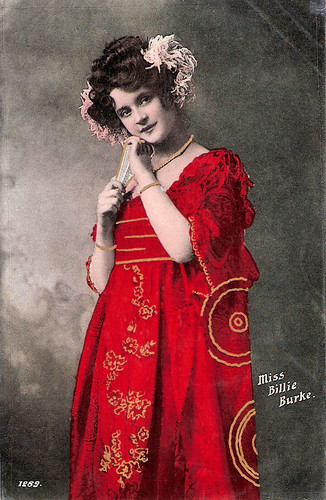
British postcard by The Rapid Photo Printing Co. Ltd., London, no. 1289. Printed in Belgium.
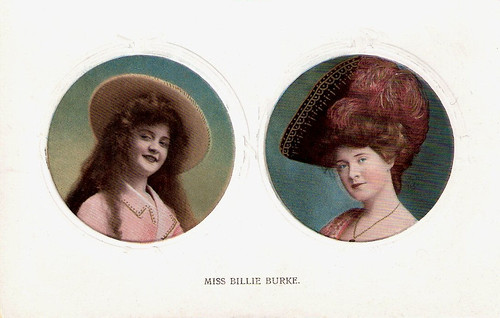
British postcard by The Philco Publishing Co., London, Series 2125 C.
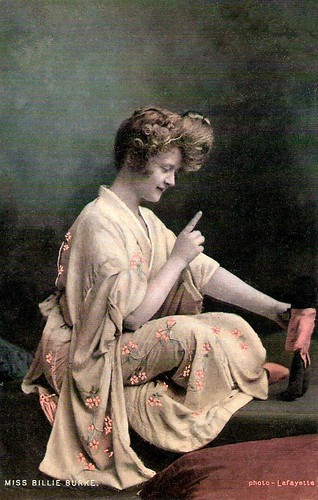
British postcard in the National series by Millar & Lang Ltd. Art Publishers, Glasgow and London, mailed in 1906. Photo: Lafayette.
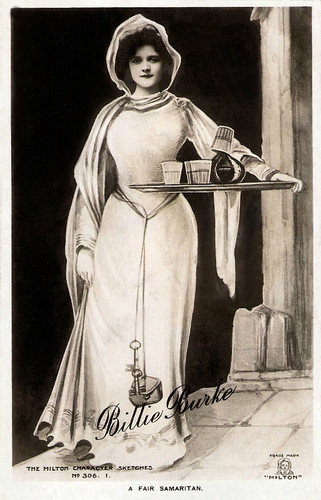
British postcard by Milton, Woolstone Bros, London E.C. in The Milton Character Sketches series, no. 306, 1. Caption: A fair Samaritan.
Playing a scatterbrained high-society wife
On 'Black October' in 1929, Florenz Ziegfeld's and Billie Burke's stock investments were wiped out in the Wall Street Crash, which precipitated the Great Depression. Ziegfeld was a broken man and Billie had no choice but to return to the screen to support her family.
Movies had become even bigger than ten years earlier, especially since the introduction of sound. Her first role of substance was as Margaret Fairlfield in A Bill of Divorcement (1932). She played Katharine Hepburn's mother in the film, which was Hepburn's debut. As an artist, she loved the fact that she had dialogues. Tragedy struck once again when her husband died during the shooting of the film. Burke resumed acting shortly after his funeral.
One of her career highlights came with David O. Selznick's classic comedy Dinner at Eight (George Cukor, 1933), co-starring Marie Dressler, Wallace Beery, John Barrymore and Jean Harlow. Billie turned in an outstanding performance as Mrs. Millicent Jordan, the scatterbrained society wife of a man (Lionel Barrymore) whose shipping company is in financial trouble and who was trying to get someone to loan his company money to help stave off disaster.
Her character loved to give dinner parties because a dinner affair at the Jordans had a reputation among New York blue-blood society as the highlight of the season. With all the drama and intrigue going on around her, her main concern is that she is one man short of having a full seating arrangement. The film was a hit and once again Billie was back on top. She had found the character that she would play for the rest of her career: the hapless, feather-brained lady with the unmistakably high voice who would be more interested in little details than what was at hand.
MGM filmed a sanitised biopic of Florenz Ziegfeld, The Great Ziegfeld (Robert Z. Leonard, 1936), which won Academy Awards for Best Picture and Best Actress (Luise Rainer as Ziegfeld's common-law wife, Anna Held). William Powell played Flo Ziegfeld and Myrna Loy played Burke, which infuriated Billie Burke because she was under contract to the studio and could have played herself. MGM considered her too old to cast in the part of her younger self.
In 1937, Billie Burke had one of her most fondly remembered roles in the comedy Topper (Norman Z. MacLeod, 1937), about a fun-loving couple (Cary Grant and Constance Cummings), finding that they died and are now ghosts, who decide to shake up the stuffy lifestyle of a friend of theirs (Roland Young as Mr. Cosmo Topper). The film would ultimately spin off two sequels, Topper Takes a Trip (Norman Z. McLeod, 1938) and Topper Returns (Roy Del Ruth, 1941) for producer Hal Roach. Billie Burke played the twittering and daffy Mrs. Clara Topper with her usual fluffy performance, and all three films were box-office hits.
In 1938, Billie received her first and only Academy Award nomination for her portrayal of Emily Kilbourne in Merrily We Live (Norman Z. MacLeod, 1938). This was probably the best performance of her screen career. She was destined to be immortalised forever as Glinda, the Good Witch of the North in the classic The Wizard of Oz (Victor Fleming, 1939), starring Judy Garland. She had previously worked with Garland in the film Everybody Sing (Edwin L. Marin, 1938), in which she played Judy's histrionically hysterical actress-mother.
The 1940s saw Billie busier than ever - she made 25 films between 1940 and 1949, including The Man Who Came to Dinner (William Keighley, 1942) with Bette Davis. On CBS Radio, The Billie Burke Show was heard on Saturday mornings from 1943 until September 1946. Portraying herself as a featherbrained Good Samaritan who lived "in the little white house on Sunnyview Lane," she always offered a helping hand to those in her neighbourhood. In the cinema, she started another series with Father of the Bride (Vincente Minnelli, 1950) featuring Spencer Tracy and Elizabeth Taylor, and the follow-up Father's Little Dividend (Vincente Minnelli, 1951). She next went to television with the TV series Doc Corkle (1952), but the series was cancelled after three weeks.
Her ageing became noticeable now. Burke wrote two autobiographies, both with Cameron Van Shippe, With a Feather on My Nose (Appleton, 1949) and With Powder on My Nose (Coward McCann, 1959). She was 75 when she made her final screen appearance as Cordelia Fosgate in John Ford's Western Sergeant Rutledge (1960) with Jeffrey Hunter and Woody Strode. Billie Burke retired for good and lived in Los Angeles, California, where she died at age 85 of natural causes in 1970. She was interred at Kensico Cemetery in Valhalla, New York, USA.
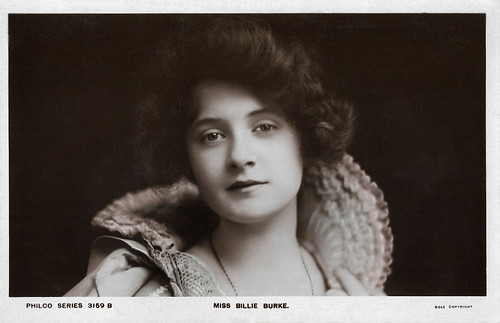
British postcard in the Philco series by The Philco Publising Co., London, no. 3159 B.
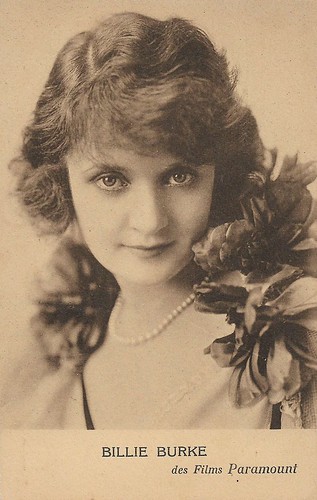
French postcard. Photo: Paramount.
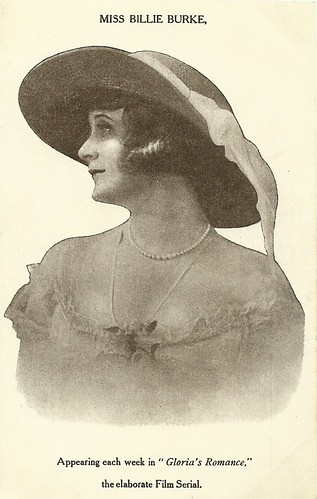
British postcard. Billie Burke in the serial Gloria's Romance (Walter Edwin, Campbell Gollan, 1916), produced by George Kleine.
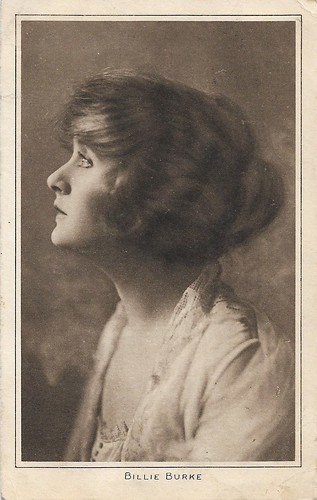
British postcard in the 'Picture' Portrait Gallery, London.
Sources: Tony Fontana (IMDb), Denny Jackson (IMDb), Wikipedia and IMDb.
This post was last updated on 21 August 2023.
No comments:
Post a Comment